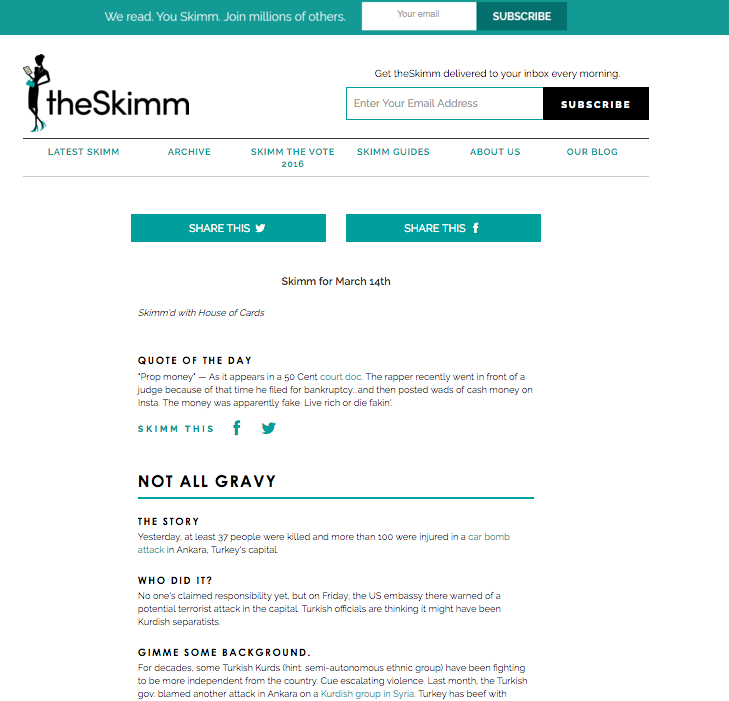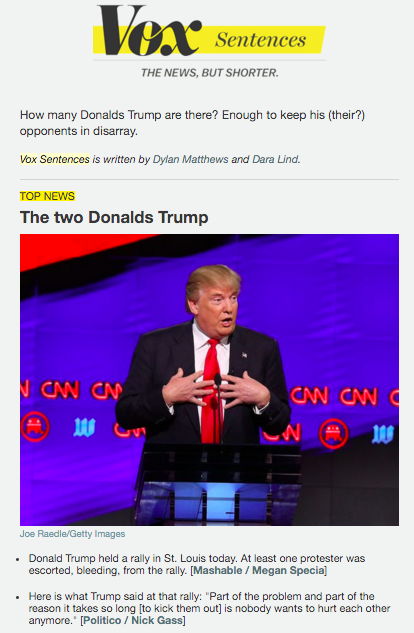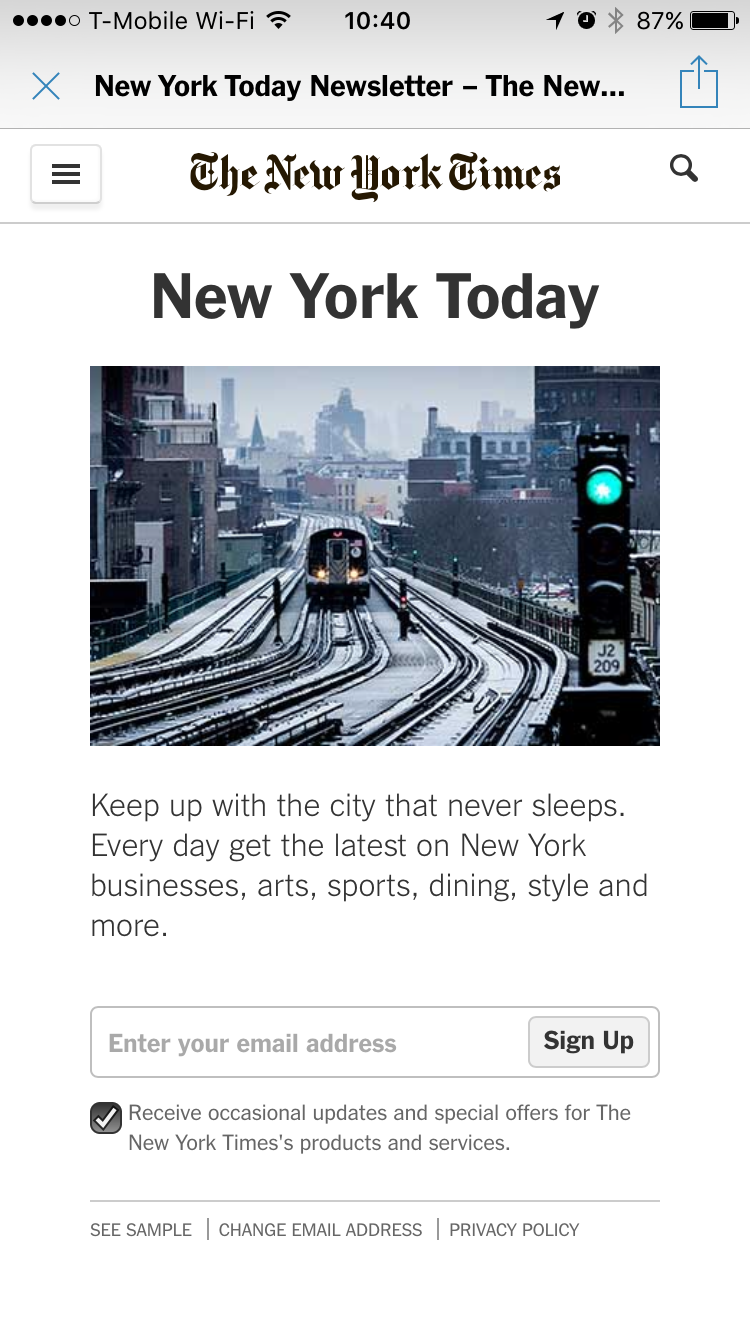The rise of the newsletter

In recent years, lots of newsletter mediums showed up in consumers’ inboxes. Goop was founded by Gwyneth Paltrow in 2008 and started as a newsletter to friends. “When I hit send on the first Goop newsletter at my kitchen counter in 2008, I had no expectations: a weekly newsletter seemed like a fun thing to do, not a serious business”, Paltrow explains on the website. Goop has expanded into a serious media brand and online retailer today. Paltrow also started an organic food line, an all-natural makeup collaboration with Juice Beauty, and last month she launched a retail line of beauty products.
TheSkimm, “the daily email newsletter to start your day”, was founded in 2012 by Carly Zakin and Danielle Weisberg. Today, they have more than 1.5 million subscribers and target women ages 22 to 34.

When actress and writer Lena Dunham launched her newsletter Lenny in September 2015, the first issue was sent out to 200,000 people. Ms. Dunham’s celebrity status certainly helped to gather large audience and media attention from the very beginning. In October, shortly after Lenny’s launch, Hearst signed an exclusive deal with Ms. Dunham and her business partner Jenni Konner to handle ad sales, content distribution across Hearst properties, and audience development for Lenny. Today, the newsletter has over 400,000 subscribers and 375,000 unique visitors across LennyLetter.com and Lenny Letter channels on Hearst websites (Cosmopolitan.com, Elle.com, MarieClaire.com, HarpersBazaar.com and esquire.com, according to Hearst Magazines Digital Media.
Another newcomer, Clover, a newsletter for teenage girls, was launched just a month and half ago by Casey Lewis and Liza Darwin, formerly of Teen Vogue and Nylon. ”We got 1K subscribers in the first day and have been scaling similarly since”, says Casey Lewis via email.

Finally, on Medium, a blog-publishing platform founded in 2012 by Twitter co-founder Evan Williams, every post finishes with a message from the author: “Did you enjoy this article? Sign up to my newsletter to get my latest articles in your inbox”. By the end of 2015, Medium published more than two million posts, and many of them included an invitation to subscribe to the author’s personal newsletter.
There are a few reasons why ten years ago we did not have any email-born mediums and today we have many to choose from. First of all, almost everyone owns a smartphone and an email app comes with it. As The Atlantic notices, “A person’s email inbox is where forgotten passwords are revived; where mass-mailings are collected; and where pumpkin-pie recipes, toddler photos, and absurd one-liners are shared”. Email is here to stay. Second, newsletter content became more sophisticated. Weisberg and Zakin of The Skimm in their interview to ReCode said they thought of email “as the best marketing tool there was.” But it is not just about marketing. Such examples as the Vox’s “Vox Sentences” and The New York Times’s “New York Today” newsletters show that it is possible to create beautiful experiences without forcing readers to ever leave their inbox and go to the websites. Finally, because of information overload, readers appreciate how the newsletter format makes it less necessary to go to a website. Derek Flanzraich, the CEO of Greatist, a website about healthy living, says that their primary platform is email. “The amazing thing about this platform is that readers actively invite you to be a part of their inbox”, says Flanzraich.
So why not introduce a medium that only exists in newsletter form, or whose primary strategy is newsletter channel?
Todd Haskell, Senior Vice President, Chief Revenue Officer of Hearst Magazines Digital Media, explains via email why Lenny’s newsletter platform is still the core of the product’s strategy despite having a website, too. “The newsletter medium uniquely supports the journalistic mission of Lenny Letter; the nature of Lenny’s content is very intimate and intensely shareable. All content lives exclusively in subscribers’ inboxes for twenty four hours before migrating onto LennyLetter.com and other Hearst websites. While the newsletter is the core product of Lenny Letter, the extension of its reach and lifespan across Hearst’s websites has been instrumental in developing a diverse and loyal audience.”

It is clear why newsletters became so popular among readers. What about advertisers? They benefit from this format too. Mobile ads are still a challenge and brands love being in consumers’ inboxes. Brands also love loyal and engaged readers that turn to their inboxes for news. The downside of the newsletter format is the smaller audience numbers than of the website. However, that does not shy away advertisers. Todd Haskell says, “Email is a premium product. Advertisers know that, and it carries a premium price point, but we also provide broader reach by extending the content to the web itself. It’s still early, but advertisers have expressed comfort in this hybrid approach.”
Business models of newsletters vary: some sell traditional ads and sponsored content, others charge for subscription and collect e-commerce fees. Making money is a challenge for these mediums. But newsletters, just like email itself, are not going anywhere and more newsletter-only brands are going to show up. “Newsletters are grounded in a strong consumer connection, and their recent renaissance is likely a result of the personal, customised experience they provide’, says Todd Haskell.
More like this
Can newsletters build habits and new revenue?







